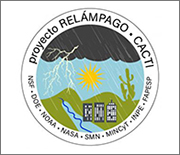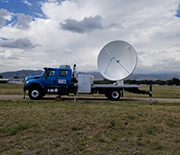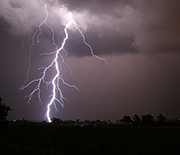News Release 18-095
Atmospheric scientists begin field campaign to study extreme thunderstorms in Argentina
Thunderstorms are larger, have more lightning, and may produce more hail and flooding than Northern Hemisphere counterparts

Researchers with RELAMPAGO-CACTI will track severe thunderstorms in South America's Pampas.
October 24, 2018
This material is available primarily for archival purposes. Telephone numbers or other contact information may be out of date; please see current contact information at media contacts.
Find related stories on NSF's geosciences risk and resilience interest area.
As residents of the U.S. Midwest know, spring in the Great Plains can bring severe weather, including hail, damaging winds, torrential rains and deadly tornadoes with catastrophic impacts.
Similarly, spring in the Pampas, a vast plains region that extends from the foothills of the Andes Mountains in Argentina to the coasts of Brazil and Uruguay, ushers in many of the same types of weather. But thunderstorms in the Southern Hemisphere are larger, have more lightning, and may produce more frequent large hail and flooding than their Northern Hemisphere counterparts.
Residents of the Pampas region know about the dangers of these storms, but the tempests are often difficult to predict.
Now an international team of scientists funded by the National Science Foundation (NSF) is heading to Argentina next month (spring in the Southern Hemisphere) as part of a field campaign to discover why these thunderstorms may be the most intense on Earth. The researchers aim to improve the prediction of severe storms.
More than 150 scientists from North and South America, including Brazil and Argentina, as well as Europe are participating. The U.S. researchers are affiliated with the University of Illinois at Urbana-Champaign (U of I), Colorado State University, University of Washington, University of Utah, Penn State, the University of Alabama-Huntsville, University of Colorado and Center for Severe Weather Research, as well as the Department of Energy and the National Center for Atmospheric Research.
"The frequency and intensity of rainfall in South America make the region an ideal natural laboratory to increase our understanding of heavy rain-producing storms around the globe," said Chungu Lu, a program director in NSF's Division of Atmospheric and Geospace Sciences, which funded the project.
Chasing storms and floods in Argentina
The projects designed to observe these deadly storms are collectively called RELAMPAGO (Remote sensing of Electrification, Lightning And Mesoscale/microscale Processes with Adaptive Ground Observations) and CACTI (Clouds, Aerosols and Complex Terrain Interactions).
The projects constitute the largest land-based atmospheric sciences field campaign ever conducted outside the U.S.
According to atmospheric scientist Steve Nesbitt of the of the U of I, lead principal investigator for RELAMPAGO, the region's topography is unique, with Pampas grasslands and mountains in close proximity. The terrain provides the ideal set-up, Nesbitt said, for the formation of severe storms that affect a wide region of South America.
"Argentina turns out to be a very special place," said Nesbitt. "Its storms are similar in some ways to those of the U.S. Great Plains, which also have severe thunderstorms, but the geography is different. That may exert important controls on how thunderstorms behave. Argentina's geography may set the stage for thunderstorms we think are the strongest on Earth."
Researchers will deploy an array of instrumentation, and track storms from formation through maturity.
Networks of fixed and mobile radars, including NSF's Dopplers on Wheels, will profile the storms' heavy rainfall, strong winds and hail.
Environments around these severe storms, thought to be important in dictating how the storms develop, will be observed with weather balloon launches as frequently as every 30 minutes; mobile weather stations; and vehicles with instruments that capture small-scale weather patterns.
Research aircraft will observe conditions aloft in the storms' very early stages. Continuous lightning-observing instruments will improve the understanding of why Argentina's storms produce extreme lightning.
As intense precipitation falls, a flood-chasing team will measure streamflow in rivers. Drones and local citizens' mobile phone apps will help monitor hail.
A last frontier in meteorology
"RELAMPAGO-CACTI will advance our knowledge of thunderstorms' deep convective clouds by deploying observation networks near these storms at important points in their life cycles," said Nesbitt, who is also a co-principal investigator of CACTI. "The results will allow us to discover how Argentina's storms become so intense.
"Given that these convective clouds are dangerous, RELAMPAGO instruments will probe these regions with remote sensing to improve computer models of what's going on inside the storms."
RELAMPAGO researchers will observe the weather in detail over a 48-day period in locations that produce thunderstorms some two-thirds of the time.
By repeatedly observing storms in the same locations with the same observation techniques, RELAMPAGO investigators will test scientific hypotheses about the formation of high-impact weather in ways that can't be done in the U.S. Great Plains.
Unique geography, unique impacts
Preliminary research indicates that, despite their appearance on radar, Argentina's storms spawn tornadoes much less frequently than similar storms in the U.S. "But the incredible amount of hail these storms produce is mind-blowing," U of I atmospheric scientist Deanna Hence said. "It causes an immense amount of damage."
Flooding is the most costly natural disaster in Argentina. Severe storms often go hand-in-hand with heavy rainfall. In addition to characterizing the storms, unique hydrometeorological measurements of land-atmosphere exchanges and river discharges will improve predictions of extreme flooding.
"Over the past five years, the region has experienced devastating floods with dramatic impacts on agriculture," said U of I scientist Francina Dominguez, who's leading the hydrometeorological effort. "The models developed by our team will provide communities with tools to improve flood predictability and water resources management."
Complex terrain, complex project
"The science community in Argentina will have a unique opportunity to access instrumentation we don't usually have in the country," said Paola Salio, an atmospheric scientist at the University of Buenos Aires and the RELAMPAGO Argentina principal investigator. "The data we collect will allow us to improve our knowledge of the initiation and growth of these unique storms. We need to improve our public warnings of these monster storms."
A team of forecasters from Argentina and the U.S. will provide twice-daily weather briefings to the project's investigators. A separate forecast team will help with "now-casting" short-term weather changes.
The project is also funded by the U.S. Department of Energy, National Oceanic and Atmospheric Administration, National Aeronautics and Space Administration, and South American federal and provincial agencies.
Please visit RELAMPAGO-CACTI for more information.
-NSF-
-
Scientists working on RELAMPAGO-CACTI will study some of the world's most intense thunderstorms.
Credit and Larger Version -
Map showing the Pampas, site of RELAMPAGO-CACTI.
Credit and Larger Version -
A new radar on NSF's Doppler on Wheels will provide storm-penetrating coverage in RELAMPAGO.
Credit and Larger Version -
An approaching severe storm in Argentina's Pampas region.
Credit and Larger Version -
A cloud-to-ground lightning strike during a nighttime thunderstorm in the U.S. Midwest.
Credit and Larger Version
Media Contacts
Cheryl Dybas, NSF, (703) 292-7734, email: cdybas@nsf.gov
The U.S. National Science Foundation propels the nation forward by advancing fundamental research in all fields of science and engineering. NSF supports research and people by providing facilities, instruments and funding to support their ingenuity and sustain the U.S. as a global leader in research and innovation. With a fiscal year 2023 budget of $9.5 billion, NSF funds reach all 50 states through grants to nearly 2,000 colleges, universities and institutions. Each year, NSF receives more than 40,000 competitive proposals and makes about 11,000 new awards. Those awards include support for cooperative research with industry, Arctic and Antarctic research and operations, and U.S. participation in international scientific efforts.
Connect with us online
NSF website: nsf.gov
NSF News: nsf.gov/news
For News Media: nsf.gov/news/newsroom
Statistics: nsf.gov/statistics/
Awards database: nsf.gov/awardsearch/
Follow us on social
Twitter: twitter.com/NSF
Facebook: facebook.com/US.NSF
Instagram: instagram.com/nsfgov





